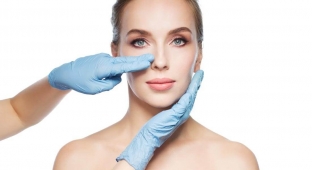Rehabilitation after rhinoplasty – a process that lasts from the end of the operation to a year. The first month after surgery is the most important. It requires regular examination of patients, adjustment of treatment regimens, appointment of additional restorative procedures. So how should a doctor behave, what medications should he stop on and what advice should he give in order to undergo rehabilitation with minimal unpleasant symptoms? How to manage the patient after surgery? Let's understand in detail with estet-portal.com.
Patient management in the first seven days after rhinoplasty
First week of rehabilitation after rhinoplasty – the most important, but most uncomfortable period, when the patient experiences pain, difficulty in nasal breathing and poor general well-being. The first day is spent in a hospital, under the close supervision of medical personnel.
Nasal turundas are changed as they get wet, monitor the condition of the plaster splint, provide sufficient pain relief to reduce pain. Regular thermometry will allow you to timely detect a rise in temperature and prescribe the necessary amount of medical care.
Plaster is removed on the 7th-12th day of rehabilitation after rhinoplasty. Until the moment of removal, patients are forbidden to displace and wet it on their own. The sutures on the skin are removed for 4-6 days. Catgut applied on internal sutures resolves on its own.
Features of follow-up in the late postoperative period
After the first day after cosmetic surgery, patients are transferred to outpatient treatment. In the rehabilitation department, only bandaging and removal of nasal turundas are carried out. The doctor makes the following recommendations:
- do not remove the splint. This will reduce the cosmetic effect of the operation,
- the first few days the temperature may rise to subfebrile numbers, so you need to have antipyretics on hand. The first few days at home are best spent in bed,
- treat the nasal cavity regularly to avoid the development of infection. Ideally, if the patient is observed in the clinic,
- observe a sparing motor and voice mode, laugh less, do not nod sharply,
- for severe nasal congestion, nasal drops are prescribed.

In order for the rehabilitation after rhinoplasty to be successful, there are categorical prohibitions in the postoperative period, which the attending doctor is obliged to familiarize the patient with:
- sleep only in the supine position, with the head of the bed high or on a high pillow,
- give up wearing glasses for 3 months,
- to exclude cold showers and hot baths, not to mention visiting saunas and Russian steam rooms,
- do not visit the pool, beach, places with open sun for at least 2 months,
- take all measures to prevent seasonal colds and allergies,
- do not consume alcohol, strongly smelling spices, too, hot or too cold food in the first 2 weeks,
- protect your overall health: don't lift heavy things, get more rest, avoid stress, etc.
Rehabilitation after rhinoplasty: drugs of choice and procedures
Here is a list of groups of medicines of choice that can facilitate the course of rehabilitation after rhinoplasty:
- to relieve swelling and bruising,
- to reduce the visibility of scars,
- for the treatment of nasal passages,
- for pain relief,
- to reduce elevated nasal temperature.
A highly qualified plastic surgeon will conduct rehabilitation after rhinoplasty on a confidential basis, because there must be full psychological contact with the patient. Explain the need for medication, the approximate time for the disappearance of bruises and scars.
Laser resurfacing (not less than 12 months after the operation) will remove postoperative scars. In the process of rehabilitation after rhinoplasty, physiotherapy is prescribed: microcurrent therapy, ultraphonophoresis. In case of swelling of the periosteum, special techniques and massage are indicated: uniform compression of the nose with both fingers, kneading the cartilage, etc. The technique will allow you to fix the results after the operation.
Read also: Three-point non-surgical rhinoplasty: technique and results







Add a comment